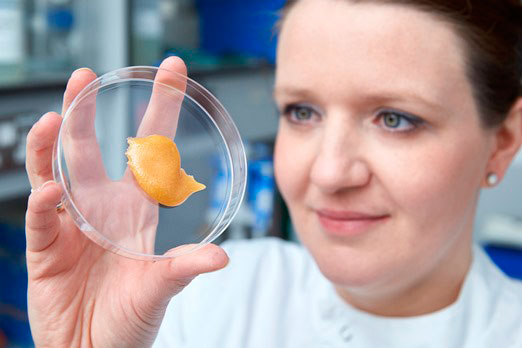
Fenella Halstead.

Fenella Halstead.

Fenella Halstead.
The engineered honey which uses sustained, low levels of Reactive Oxygen to disrupt bacterial biofilm, is already being used on patients to improve healing of infected, long-term wounds.
Biofilms are slimy, glue-like membranes that protect microbes from the body’s immune system and increase their resistance to antibiotics. Evidence suggests that biofilms are present in most chronic, non-healing wounds with a recent study suggesting prevalence could be as high as 78 per cent.
But there is good news: scientists have discovered SurgihoneyRO™ can curb the growth and activity of bacterial biofilm found in chronically infected burns and wounds. The gel becomes active on contact with the wound exudate.
The findings, published in the Journal of Wound Care, found SurgihoneyRO™ has significant activity against mature biofilms, or fixed communities of bacteria, that make wounds difficult to treat.
Fenella Halstead, a clinical scientist who led the study, said: “With the ever-increasing threat of antibiotic resistance and the recognition that conventional antibiotics taken by mouth are rarely useful to treat chronic infections, such as venous leg ulcers, there is a real need for new and novel topical antimicrobial agents.
“SurgihoneyRO™ is a key example of a topically-applied antibiotic-sparing agent and is showing real promise both clinically and in laboratory tests.”
The new study comes as the latest Public Health England guidance on common infections recognises Reactive Oxygen wound gel as a treatment for venous leg ulcers to reduce bacterial load and infection. The rationale explains it could cut unnecessary antibiotic prescribing and the amount of time community nurses currently spend dressing and treating non-healing leg ulcers.
To establish if SurghoneyRO™ has a role in eradicating mature, pre-formed biofilms, the researchers cultured 16 strains of major wound-infecting pathogens, such as Pseudomonas aeruginosa, Acinetobacter baumannii, Escherichia coli and MRSA. This involved placing suspensions of the bacteria into wells of a 96 well microtiter tray and leaving the biofilms to grow over 72 hours on plastic pegs inserted into each well. The engineered honey was then serially double-diluted with distilled water to give different strengths – 1:3, 1:6, 1:12, 1:48, 1:96, 1:384, 1:768, 1:1536, 1:3072 and 1:6144, and the biofilms placed into the wells containing the honey. Positive and negative controls were included. The plates were then sealed and incubated for 24 hours to see if SurgihoneyRO™ could significantly reduce biofilm seeding and by inference have killed some of the cells in the biofilm.
The results showed all 16 bacteria were susceptible to SurgihoneyRO™ after 24 hours with a reduction in seeding observed ranging from 58 per cent to 94 per cent. It was dose-dependent with smaller reductions in seeding of biofilms as the concentration of SurgihoneyRO™ became weaker. Even at the lowest dilution of 1:6144, there was still reduced biofilm seeding for nine out of 16 pathogens tested. The greatest effects were seen when the gel was used at the strongest concentration.
The report stated: “Using a simple and effective in vitro assay we have provided further evidence that SurgihoneyRO™ is antimicrobial and has significant activity against preformed, mature biofilms of a range of clinically important wound pathogens.
“All isolates were susceptible to SHRO and significant reductions in seeding observed following 24 hours exposure….”
The study concluded: “The in vitro finding show that SurgihoneyRO™ is antibacterial against mature biofilms, significantly reducing biofilm seeding of a range of different species of bacteria, including common wound pathogens and multi-drug resistant isolates.
“As well as reductions in biofilm seeding, we also observed reduced biofilm mass, which together would suggest that SurgihoneyRO™ has anti-biofilm properties, and consequently that the treatment does not just kill the outermost planktonic bacteria in the biofilm.
“The findings, therefore, support the anecdotal clinical data for biofilm efficacy and the topical use of SHRO for the treatment of chronic wounds where biofilms are likely to be present.”